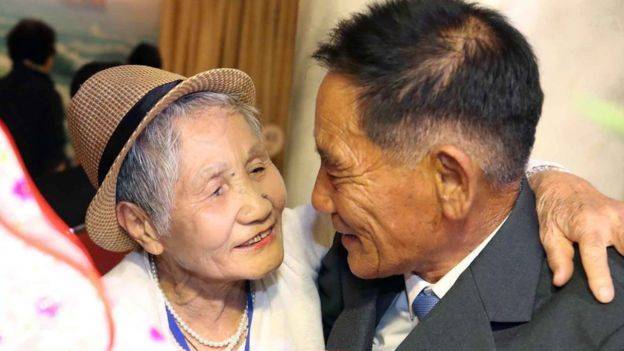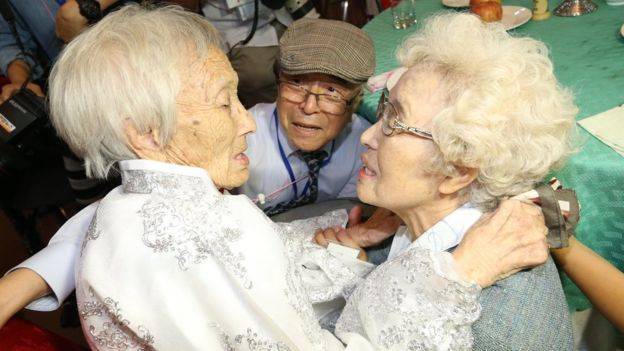A group of mostly elderly South Koreans travelled to a tourist resort in the North for the event, the first such reunion for three years.
The Korean War of 1950-1953 left the peninsula divided and people on the northern side were unable to leave.
The South Koreans were chosen by lottery - the oldest of them is 101.
These brief meetings are likely to be the last and only time many will see each other.

Eighty-six-year-old Cho Hye-do and her brother Cho Do-jae, 75, were reunited with their older sister Cho Sun-do, who is 89 and lives in North Korea.
"I remember how beautiful you were," Cho Hye-do told her big sister.
"I finally get to meet you after living for so long," replied the older woman.
Who is attending the meetings?
There are 83 North Koreans and 89 from the South taking part.
A hundred people had been selected by each side, but some dropped out after realising the relatives they had hoped to see were no longer alive.
Lee Keum-seom, aged 92, saw her son for the first since the end of the war.
She said she lost track of her little boy, then aged four, and her husband in the panic of trying to flee.
"I never imagined this day would come," she told AFP. "I didn't even know if he was alive or not."
Sisters Kim Gyong-sil, 72, and Kim Gyong-yong, 71, wore traditional dress to meet their 99-year-old mother, Han Shin-ja. She had travelled from the South to see them.
How will the meetings play out?
The South Koreans travelled by bus over the heavily guarded border to the Mount Kumgang tourist resort on Monday.
They are due to spend three days in North Korea but only be with their relatives for a few hours each day - in total, only 11 hours. Most of their visit will be heavily supervised.
Many brought gifts like clothes, medicine and food for their relatives in the much poorer North.
"I've prepared for him some household medicine including digester and headache pills, nutritional supplements as well as some daily necessaries," Lee Soo-nam, 76, who was due to meet his older brother, told Reuters news agency.

Several doctors and nurses travelled with the group to set up an emergency medical centre for the elderly participants.
What about those not taking part?
Millions of people were separated by the war. For the tens of thousands still alive in the South who have not been selected for the reunions there are other ways they can contact their relatives.
Organisations like the Inter-Korea Separated Family Association or the Korea Red Cross have in the past organised virtual reunions as well as face-to-face.
Divided families can exchange letters, have live video meetings or family reunions in third countries, if someone ended up living outside the Koreas.
In those cases, the South Korean government covers the travel and accommodation expense.
Some separated families also take a private route to contact their families in the North through Chinese brokers.
Unofficial reunions can cost about $1,500 (£1,170), but the process can be faster and is less dependent on the political climate between North and South.
How did the latest reunions come about?
The event, which is facilitated by the Red Cross, is the outcome of a historic meeting between North Korea's Kim Jong-un and South Korean President Moon Jae-in at the border in April.
The two leaders met a second time in May, where they agreed to resume family reunions, and are expected to meet again in the coming weeks.
South Korea has also taken an active role in trying to broker talks between Pyongyang and Washington.
In June, Kim Jong-un met US President Donald Trump in Singapore where they pledged to work towards denuclearisation, although there are doubts over how genuine the North is in its commitment.
More about:
















































